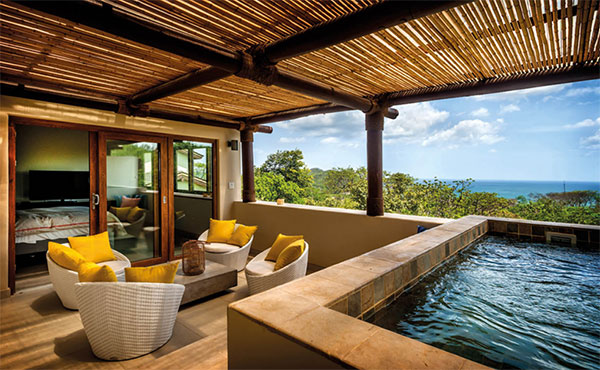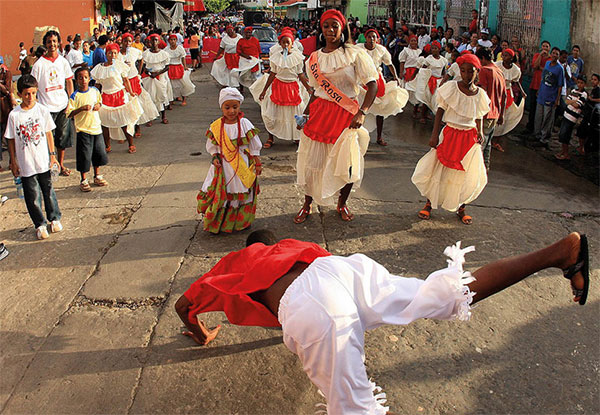North of the long, mostly undeveloped beaches of Playa Amarilla and Playa Colorado is Playa Santana, which is really five beaches. The 1,100-hecatre (2,700-acre) Rancho Santana (www.ranchosantana.com) is an intentionally rugged, private complex with multiple residential communities that share a beach club, organic farm, and surf center. A clubhouse and hotel complex on the northern end of the property is the hub of activity.

How the other half live; the penthouse suite at the Mukul hotel.
Leonardo
The road is still being paved to Playa Popoyo, which is one of the premier surfing destinations in Nicaragua. Farther north is the Refugio de Vida Silvestre Río Escalante-Chacocente, a remote wildlife refuge where thousands of Olive Ridley turtles, as well as four other types, come to nest from July to December.
Fact
The name ‘Nicaragua’ was given to the country by the Spanish, who combined the name of a chief of an Indigenous tribe called ‘Nicarao’ in the náhuatl language and the Spanish word ‘agua,’ or water, after the lake.
The Caribbean coast
The Caribbean coast of Nicaragua, formerly known as the Mosquito Coast, takes on a character that is more like the Bay Islands and coasts of Honduras and Belize than the rest of Nicaragua. Fierce Miskito resistance, plus British support of Mosquito kings from 1655 until 1860 – claiming the region as a protectorate in exchange for access to isolated bays and coves – prevented the Spanish from conquering the region. It wasn’t until 1894 that Nicaraguan president Zelaya marched into Bluefields to lay claim to the coast, but even today, amidst calls for autonomy and after so many years apart, it feels like a land joined in name only with the rest of Nicaragua.
Many in the region speak creole and still have English surnames, the same ones as the pirates that once frequented the area, such as Morgan and Dampier. Along the lagoons and muddy rivers surrounded by thick tropical forests are communities of Indigenous Miskito, Mayangna, Rama, and Garífuna, who maintain their own way of living in the wild terrain. There is real, unabashed culture here that doesn’t know air-conditioned malls or cable TV. The entertainment in gritty towns like Bluefields involves colorful parades fueled by sugarcane liquor and calypso.
Managua to the Caribbean
From Managua, Highway 7 runs parallel in spots to the Mico River, passing through Juigalpa ‚ [map] , where there’s a small archeological museum, the Museo Arqueológico Gregorio Aguilar Barea (daily 8am–5pm), which is home to the most important of Pre-Columbian stone stelae in Nicaragua. More than 100 of the basalt statues were carved between 800 and 1500 AD. Finally, the road comes to El Rama, a town of 50,000 that’s six hours from Managua. This isolated port on the Escondida River is as far east as you can go by road. From here, tiny prop-planes and riverboats run to the coast at Bluefields.

Dancing in Bluefields during Palo de Mayo.
Photoshot
Bluefields
Named after a Dutch pirate named Blewfeldt, the port town of Bluefields ⁄ [map] is a mish-mash of cultures, from West Indian and Miskito to mestizo. Crime is high here, partially because of the influx of money from the transit of cocaine passing from South America to the north. The town itself, set between docks and jutting out into the bay on floating restaurants, is not particularly attractive at first glance, with ramshackle buildings and a murky bay. The town’s most interesting attraction is the wood-paneled Moravian Church near the municipal pier, which dates from 1848, although it’s been mostly rebuilt since Hurricane Juana in 1988, which wiped out many of the Victorian buildings that once lined the brick streets. Attached to the church is a cultural museum with Miskito artifacts, including a sword that belonged to the last Miskito king.
The nightlife in Bluefields is raucous, even legendary, and is reason enough to make a trip here. They call Bluefields the Jamaica of Nicaragua, and ‘Maypole,’ a style of tropical calypso with raunchy lyrics and dance moves, is the town’s claim to fame, with the beat blasting at full volume in grungy discos like Four Brothers and Fresh Point. Things get even crazier during Palo de Mayo, a festival that takes place throughout the month of May. The event celebrates when a maypole was erected in the center of town, decorated with ribbons in flowers, during the town’s early days to mark the coming of spring. Today, the festival is an excuse to party, with drunken parades and dancing that goes on until the wee hours of the morning.
Laguna de Perlas
Reached by pangas (small boats) through a network of canals each day from Bluefields (three hours), the town of Pearl Lagoon was once considered to be the second capital of the Miskito Kingdom, after the last Miskito king took up residence after being deposed in Bluefields in 1894. Today, it’s a relaxed fishing village with dirt roads where reggae wafts through the air. Visitors chill in over-water wooden restaurants with thatched roofs, sampling soulful plates of seafood and cheap beer. There are no beaches here; for those, travelers will need to hire a boat to the Pearl Cays (for more information, click here). You can visit the Miskito community of Awas, 3km (1.8 miles) west, or the Garífuna village of Orinoco on the other side of the lagoon, reached by boat. The fishing is good here, with opportunities to catch tarpon and snook in the lagoon, plus yellowtail and bonefish in the open sea.